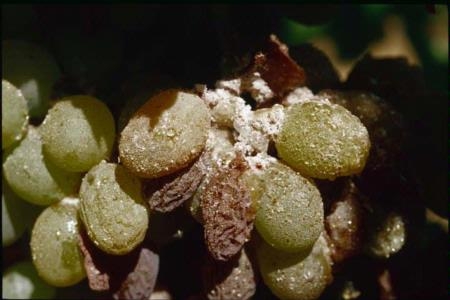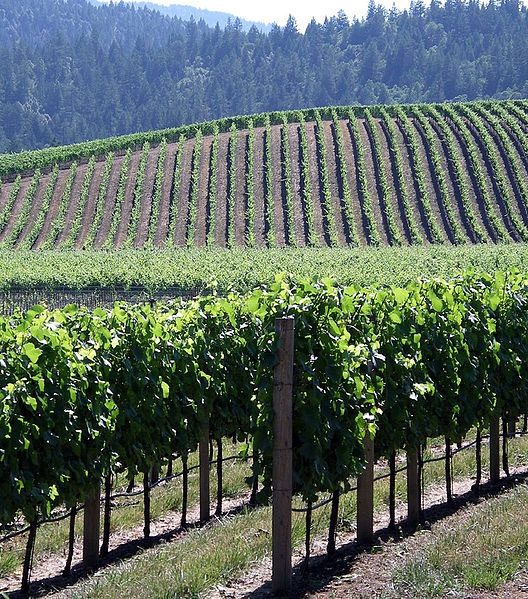Posts Tagged: Kent Daane
UC Cooperative Extension reaching out to NorCal cannabis growers
UC Cooperative Extension in Humboldt County has invited local cannabis farmers to meetings this week to discuss ways to reduce the industry's environmental impacts, reported Will Houston in the Eureka Times-Standard.
UC advisors and specialists will discuss future research aimed at reducing the impacts of pesticide and fertilizer use on cannabis grows.
At this week's meetings, Giraud said, "Mostly we just want to listen to folks who come to the meetings ideas and concerns. They're on the ground. We just want to know what could be planned with us."
The meetings will be from 6 to 8 p.m. Oct. 3 at Adriana's Restaurant, 850 Crescent Way, Arcata; and 12 to 2 p.m. Oct. 4 at Women's Civic Club, 477 Maple Lane, Garberville.
There will be brief presentations followed by group discussions. The UC participants include Van Butsic, UC Cooperative Extension land use science specialist at UC Berkeley; Kent Daane, UCCE biological control specialist at UC Berkeley; Houston Wilson, post-doctoral researcher at UC Berkeley; and Giraud.
Organic farmers are counting on UC to control exotic Virginia creeper leafhoppers
“They lost too much income,” said Glenn McGourty, a UC Agriculture and Natural Resources Cooperative Extension advisor in Lake and Mendocino counties. “They decided they were not going to risk their crop until there is a workable biological control solution to this new pest.”
Meanwhile, other organic grape producers are hanging on to their organic certification and counting on UC ANR researchers to come through with a biological control option soon.
“Organic farmers are spending a couple hundred dollars per acre for organic pesticides,” McGourty said. “They don't want to use them. It takes out beneficial insects and it doesn't even control Virginia creeper leafhopper very well.”
Three leafhopper species are pests of California grapes. Western grape leafhopper is a native insect that's present throughout California north of the Tehachapi Mountains. Several natural enemies keep the pest in check most years. Variegated leafhopper migrated north from the Imperial Valley to Central California in the 1980s, and is established in Napa Valley and other valleys of Napa County. Virginia creeper leafhopper, a native of the northern Midwest, made its way to Northern California in the early 1980s. It migrated southward to the northern Sacramento Valley and Sierra foothills, and most recently was detected in Lake and Mendocino counties, where the population boomed.
“The farmers were devastated, especially financially,” McGourty said. “Conventional growers had to begin spraying pesticides. Some organic vineyards were completely defoliated.”
The leafhoppers' key natural enemies are fairyflies (Genus: Anagrus), among the tiniest flying insects in the world. Certain species of fairyflies attack certain species of leafhoppers. What has scientists perplexed at the moment is the fact that Virginia creeper leafhoppers' natural enemies are present in Mendocino and Lake counties, but they are failing to do their job.
Generally, fairyflies lay their eggs in leafhopper eggs, killing them. The fairyflies known to attack Virginia creeper leafhopper are successfully parasitizing the pest's eggs in Yolo County. However, the very same species of fairyfly is not recognizing Virginia creeper leafhopper eggs as a host in Mendocino and Lake counties.
“Virginia creeper leafhopper only recently moved into the Mendocino area,” said post-doctoral researcher Houston Wilson. Wilson works in the lab of Kent Daane, UC ANR Cooperative Extension specialist based at the UC Kearney Agricultural Research and Extension Center in Parlier. “Although these Anagrus parasitoids can attack both Western grape leafhopper and Virginia creeper leafhopper, the Anagrus population in Mendocino County has been reproducing on Western grape leafhopper for so long, they seem to have lost their preference for Virginia creeper.”
The scientists believe that, in time, fairyflies in Lake and Mendocino counties will begin to parasitize Virginia creeper leafhopper eggs on their own. But, because of the severity of the situation to organic winegrape growers, they've hatched a plan to help out the natural enemies. This summer, they will be rounding up fairyflies in the Davis area – where they know how to attack Virginia creeper – and bring them to Lake and Mendocino county vineyards.
Beginning in April, Wilson will allow Mendocino area Virginia creeper leafhoppers to lay eggs on potted grapevines. The vines will be transported to Davis, where local fairyflies can parasitize the eggs. The plants will go back to the laboratory in Berkeley so scientists can rear populations of the parasitoids and later release them in Mendocino and Lake county vineyards.
“I just planted the grapevines this month,” Wilson said. “When leafhoppers become active in the summer, we'll start monthly releases. We hope our efforts will take some of the pressure off winegrape farmers soon.”
In addition to the work releasing natural enemies of Virginia creeper leafhopper, UC Agriculture and Natural Resources scientists are implementing an area-wide integrated pest management program in Mendocino and Lake counties. The program – a combination of biological, cultural and chemical controls for this pest – employs:
- Improved monitoring and mapping of Virginia creeper populations
- Cultural practices to reduce egg deposition in vineyards
- Earlier and coordinated pesticide applications (if a spray is necessary)
The Virginia creeper leafhopper pest control program is funded in part by the American Vineyard Foundation.
An initiative to manage endemic and invasive pests and diseases is part of UC Agriculture and Natural Resources Strategic Vision 2025.
Raisins are the focus of the 2014 San Joaquin Valley Grape Symposium
Over the last 10 years, Fresno County farmers have reported increasing raisin moth populations in organic raisin vineyards. Addressing this concern, Kent Daane, UC Cooperative Extension specialist in the Department of Environmental Science, Policy and Management at UC Berkeley, will update growers on the pest’s biology, management and damage at the San Joaquin Valley Grape Symposium Jan. 8 in Easton.
Daane and his research associates followed moth populations in organic and conventional fields to document this observed change and determine if there were any specific causes for increases in raisin moth densities. In a 2013 season study, UC Kearney Agricultural Research and Extension Center entomologists found that spring to early summer pheromone trap catches of raisin moths were prevalent across numerous vineyards, regardless of management practices. However, overall seasonal damage in 2013 was low.
“The primary difference between vineyard sites with or without raisin moth damage appeared to be well-timed and effective insecticide sprays,” Daane said. “One problem for organic sites may be the availability of insecticide materials that have long enough residual activity to control the larvae of adult moths entering the vineyard, and once the larvae are deep inside the grape cluster they are difficult to control.”
In addition to Daane’s report, the San Joaquin Valley Grape Symposium includes the following research updates:
- Rootstocks for raisin production by Sonet Von Zyl, Fresno State University
- Raisin production canopy management by Matthew Fidelibus, UC Cooperative Extension specialist in the Department of Viticulture and Enology at UC Davis, based at the UC Kearney Ag REC in Parlier
- Raisin grape breeding program by Craig Ledbetter, USDA Agricultural Research Service, based in Parlier
- Economics of producing raisins, by Annette Levi, Fresno State University
- Grapevine trunk diseases and grower survey
The symposium begins with registration at 7 a.m. and concludes following lunch at 1 p.m. at the C.P.D.E.S. Hall, 172 W. Jefferson Ave., Easton, Calif.
Registration is $15 in advance and includes lunch. Registration at the door is $20. To preregister, send the names of attendees and a check payable to UC Regents for $15 each to San Joaquin Valley Grape Symposium, 550 E. Shaw Ave., Suite 210-B, Fresno, CA 93710. To register with a credit card, fill out the online registration form at http://ucanr.edu/sjv2014.
'Great Day' morning program features UC Kearney Ag REC
The popular morning television program "Great Day," which airs daily on KMPH Channel 26 in Fresno, featured the work of scientists at the UC Kearney Agricultural Research and Extension Center in six live segments during the five-hour program this morning.
Reporter Clayton Clark and photographer Ryan Hudgins arrived at the Kearney greenhouse at 4:30 a.m. to interview the scientists helping California farmers feed the nation and world sustainably.
See clips of the interviews in the one-minute video below:
Segments included:
- An overview of research and extension activities at Kearney by director Jeff Dahlberg.
- UC blueberry and blackberry research that has made these commodities important crops in the San Joaquin Valley with Manuel Jimenez, UC Cooperative Extension farm advisor in Tulare County.
- Beneficial insects, pests and invasive species that are part of research by Kent Daane, UCCE specialist in the Department of Environmental Science and Policy Management at UC Berkeley. Daane shared a handful of leaf-footed bugs with the reporter.
- How global information systems are changing the way farmers and researchers are looking at farmings systems with Kris Lynn-Patterson, coordinator of the GIS program at Kearney.
- Just like people, plants get sick. UC plant pathologist Themis Michailides explained research efforts to cure plant diseases.
- Uncommon wine varieties that might lead to new fine wines ideally suited to be produced in the Valley's warm climate, with Matt Fidelibus, UCCE specialist in the Department of Viticulture and Enology at UC Davis.
- The very real threat of West Nile virus in mosquitoes in the valley, with medical entomologist Anton Cornel.
Grape leafroll virus a headache for California farmers
Two relatively new variants of grape leafroll virus, known as V3 and V5, are alarming some winegrape growers in California's famed wine country, according to an article yesterday in the San Francisco Chronicle.
The virus is spread by grafting infected cuttings and by the feeding of vine mealybug. It won't kill the vineyard, but it will prevent normal sugar development and reduce yields.
The Chron article, written by Alice Feiring, said the late Ed Weber, Napa County's previous UC Cooperative Extension viticulture farm advisor, and Deborah Golino, director of Foundation Plant Services at UC Davis, in 2002 began a four-year study of the virus in an Oakville vineyard. During the study, there was a threefold increase in the number of infections in that vineyard alone.
UC Berkeley biological control specialist Kent Daane told the reporter that pesticides are not effective against vine mealybug because the bugs hide under leaves. A better control measure, Daane believes, is pheromone mating-disruption.
Nevertheless, Golino told the paper there will not be a fast fix. She encourages growers to purchase certified virus-free vines, "even when it means giving up field selections that have been a longtime part of a winemaking program."
The article also reported there is circumstantial evidence that shows vineyards managed organically might have natural predators for the vine mealybug.
"We don't see the problem in our organic vineyards as we do in our conventional," a farmer was quoted in the story. "But I'm not prepared to say that's the reason."

Vine mealybug feeding destroys grape clusters and spreads viruses.




